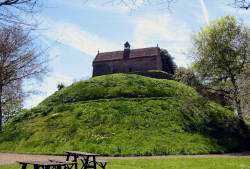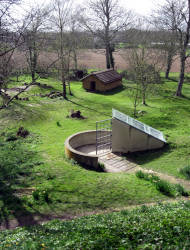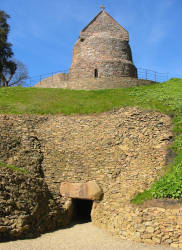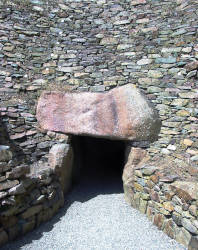La Hougue Bie
Useful Information


| Location: |
La Route de la Hougue Bie, Grouville, Jersey JE3 9HQ.
(49.200321, -2.063608) |
| Open: |
MAR to OCT daily 10-17. NOV to DEC daily 10-16. Closed 24-DEC, 25-DEC, 26-DEC, 31-DEC. [2023] |
| Fee: |
Adults GBP 11.35, Children (6-16) GBP 7.40, Children (0-5) free, Students (-26) GBP 7.40, Seniors (65+) GBP 10.20, Families GBP 33.75. Groups (10+): Adults GBP 9.65, Seniors (65+) GBP 8.67, booking required. [2023] |
| Classification: |
 Cave Tomb Cave Tomb
 World War II Bunker World War II Bunker
|
| Light: |
 Electric Light Electric Light
|
| Dimension: | L=20 m. |
| Guided tours: | self guided |
| Photography: | allowed |
| Accessibility: | no |
| Bibliography: | |
| Address: |
La Hougue Bie, La Route de la Hougue Bie, Grouville, Jersey JE3 9HQ, Tel: +44-1534-853-823.
E-mail: |
| As far as we know this information was accurate when it was published (see years in brackets), but may have changed since then. Please check rates and details directly with the companies in question if you need more recent info. |
|
History
| 1925 | excavated by the Société Jersiaise. |
Description


La Hougue Bie is sometimes said to be one of the 10 oldest buildings of the world. The Neolithic passage grave was built 6,000–5,500 BP and has a chamber which was built to align with the rising sun at spring and summer equinox. It is covered by a mound, on which a Christian chapel with spectacular views was built during the 16th century. Hougue is a Jèrriais/Cotentin word for heap or mound, related to the Old Norse word haugr. What Bie means is unknown, but there is a legend about a Medieval knight who fought a dragon and was named Hambyr. It is one of five passage graves with side chambers on the Channel Islands.
A passage grave is, as the name says, a passage, in this case 20 m long in total, which was built by erecting huge flat stone plates and then covering them with a 12 m high mound. The entrance passage is 9.7 m long and leads to a main chamber. From here three smaller side chambers branch off, which makes a cross-like layout. The side chambers are separated by standing stones, only with a small opening. There was originally an open entrance, the site was used for ceremonies, and the main purpose was a temple, not a grave. So the grave part of the name is basically a 19th century imagination, like modern churches the temple was also used for grave. In such megalithic passage graves people were rarely buried, they were first cremated and then the ashes were stored in the grave, either in leather pouches or in ceramic vases. The passage was not big enough to bury all the dead of the huge community which was necessary to build it. When it was excavated the passage contained fragments of twenty vase supports, scattered remains of at least eight individuals, and grave goods, mostly pottery. It seems that the tomb was once opened and looted by grave robbers, but it is unclear by whom and when.
The site is a compound which is called the La Hougue Bie Museum, which actually includes an archaeological museum, the mound with grave, the chapel, a reconstructed Neolithic Longhouse, a German command bunker from World War II, and the La Hougue Bie Tea Rooms. The experimental archaeology at the longhouse gives an insight about life in the New Stone Age. The museum houses the exhibit Unearthing Le Câtillon II about the world’s largest Celtic coin hoard. 70,000 coins and jewellery were buried 2,000 years ago. The command bunker contains an exhibition on forced workers brought to Jersey by Organisation Todt. The combination is weird, but actually there are two reasons to list it on showcaves.com .
 Search DuckDuckGo for "La Hougue Bie"
Search DuckDuckGo for "La Hougue Bie" Google Earth Placemark
Google Earth Placemark La Hougue Bie - Wikipedia (visited: 01-MAY-2023)
La Hougue Bie - Wikipedia (visited: 01-MAY-2023) La Hougue Bie (visited: 01-MAY-2023)
La Hougue Bie (visited: 01-MAY-2023) Index
Index Topics
Topics Hierarchical
Hierarchical Countries
Countries Maps
Maps